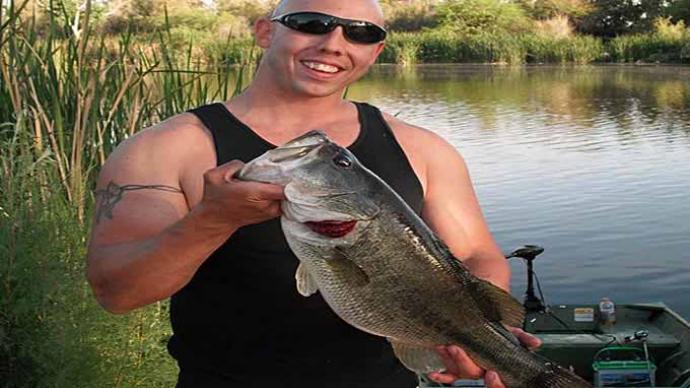
I keep things simple when chasing bass. The more I complicate things, the more I find myself chasing my tail instead of Mrs. Bass. I normally take a few rod and reel combos, a handful of plastics, jigs, hooks, weights, spinnerbaits, or topwater lures, depending on the situation.
Crankbaits, on the other hand, defy the principle of keeping it simple. Unlike soft plastics that can be rigged in numerous ways and spinnerbaits that can be used to cover most of the water column, crankbaits and topwaters are limited to a certain depth. With fall quickly approaching, the crankbait bite will be turning on and should last until the bass make their winter move to deep water. A handful of crankbaits that run at various depths should be all that is needed. However, there are other factors to consider. Those factors, if ignored, make crankbait fishing a love/hate relationship for many anglers. Choosing the wrong crankbait can result in more frustration than success. That fact can also be applied to the equipment you use when fishing crankbaits.
So how does one go about choosing the right crankbait? Square bills, coffin bills, suspending, rattling, silent, jointed, and more styles are available. You are not alone if your head spins while walking down the crankbait aisle at your favorite tackle shop. Throw in rod, reel, and line choices when crankbait fishing, and you can end up mortgaging your house attempting to cover all the options.
Priority one – Find the type of cover you will fish the most. Buoyant cranks are better suited for targeting wood or rock, as are fat-bodied baits. Thin-bodied baits are better suited for weeds or targeting suspended fish. So the question remains; How does one keep things simple regarding fishing cranks? The answer lies in your answer to two other questions.
What do you consider your skill level when it comes to crankbait fishing? What do you want the bait to do? A limited selection of cranks is all that a novice angler needs to cover a variety of depths and cover situations. Additional baits only bring about frustration when it comes to choice. The more proficient angler would opt for a larger selection, and someone at a professional level (not yours truly) may load a boat.
You'll need to be familiar with your equipment and a limited number of cranks before you buy every crankbait in multiple colors and patterns. Use those few baits enough to distinguish how the baits feel when deflecting off objects and when you’re getting bites. By doing so, you'll be able to avoid a majority of hang-ups or ruining a cast and the possibility of a potential catch by bringing back a bunch of weeds.
Whatever your skill level, if you know the answer to the second question, the selection process from the baits you have on hand becomes simple. Selecting a silent, fat body, suspending crank, is simple when you know what is expected of the bait. Only reach for it if you are experienced enough to know when and where to fish it.
What Do You Want The Crank To Do?
Most companies list the running depth of their baits either on the packaging or as part of the lure's name (DT16, etc.), and most will run within a foot or so of that depth using 8-pound to 12-pound test line. Many anglers will mark their baits on the lip or underside with that suggested running depth when they first take it out of the package. Attempting to determine the running depth of a crank by the length/angle of the bill or the location of the line tie is just a guess. Choosing a crank that runs to the depth you're targeting becomes simple. Know your target depth and pick one that runs to that depth.
What about all the different lip designs? Each design serves two purposes. The first is to get the bait to its desired depth. The second is to give it a particular action on the retrieve and when it makes contact with cover or the bottom. For example, wide bills give the bait a wide wobble and deflect better off cover like wood or rock. Narrow bills give a bait a tighter wiggle and are best suited for use as bottom bouncers or use in and around weeds.
The material a crank is made of also serves two purposes – buoyancy and durability. Balsa wood, plastic, and hardwood have different rates at which they rise when paused or deflected off something. Balsa is the most buoyant. Hardwood is the least buoyant. Plastic baits can be at either end of the spectrum and hold up better than wood. Suspending cranks will have a neutral buoyancy, or at least as close to neutral as expected.
Many crankbaits have internal rattles. There are diverse beliefs on the benefits of those rattles, but most will agree that their principal purpose is to attract attention to the bait. The times it's beneficial to attract attention through noise are when water clarity is diminished or when you want the fish to know the lure is approaching. A silent crank isn't exactly quiet, but its triggering qualities are in its appearance and action. Therefore, these become a good choice for clear water applications.
If you want a crank to bump stumps in 10ft. of clear water, your choice of baits from the baits you have on hand becomes simple. Don't you have a square-lipped balsa crank that runs 10ft. deep? I've made mention of this a few times. What do you have on hand that will run at least 10ft. deep? What you have may not be the ideal choice, but it becomes simple.
Keeping it simple when it comes to crankbaits is simply a simple matter of simplicity. That is, of course, until you get into the subject of color.
I could approach that subject along with equipment selection now, but I'll wait until my head stops spinning.




